-
 Bitcoin
Bitcoin $84,022.8967
2.34% -
 Ethereum
Ethereum $1,868.2838
2.77% -
 Tether USDt
Tether USDt $0.9999
0.00% -
 XRP
XRP $2.1453
3.05% -
 BNB
BNB $612.3358
2.78% -
 Solana
Solana $127.4412
2.71% -
 USDC
USDC $1.0001
-0.01% -
 Dogecoin
Dogecoin $0.1711
4.68% -
 Cardano
Cardano $0.6759
4.88% -
 TRON
TRON $0.2353
0.73% -
 Toncoin
Toncoin $4.0848
3.73% -
 Chainlink
Chainlink $14.0148
6.01% -
 UNUS SED LEO
UNUS SED LEO $9.3543
2.85% -
 Stellar
Stellar $0.2731
3.21% -
 Avalanche
Avalanche $19.4355
4.38% -
 Sui
Sui $2.3857
7.83% -
 Shiba Inu
Shiba Inu $0.0...01278
5.25% -
 Hedera
Hedera $0.1688
5.17% -
 Polkadot
Polkadot $4.1925
4.20% -
 Litecoin
Litecoin $84.6282
3.00% -
 MANTRA
MANTRA $6.3356
0.81% -
 Bitcoin Cash
Bitcoin Cash $312.8725
4.70% -
 Bitget Token
Bitget Token $4.6137
4.16% -
 Dai
Dai $0.9999
0.00% -
 Ethena USDe
Ethena USDe $0.9998
-0.03% -
 Pi
Pi $0.6993
0.19% -
 Hyperliquid
Hyperliquid $13.5365
7.54% -
 Monero
Monero $217.9467
1.18% -
 Uniswap
Uniswap $6.1376
4.34% -
 Aptos
Aptos $5.3585
3.13%
How do nodes of blockchain reach consensus?
Blockchain consensus mechanisms like PoW, PoS, DPoS, and PBFT ensure network agreement, each balancing security, energy use, and scalability differently.
Mar 30, 2025 at 11:28 am
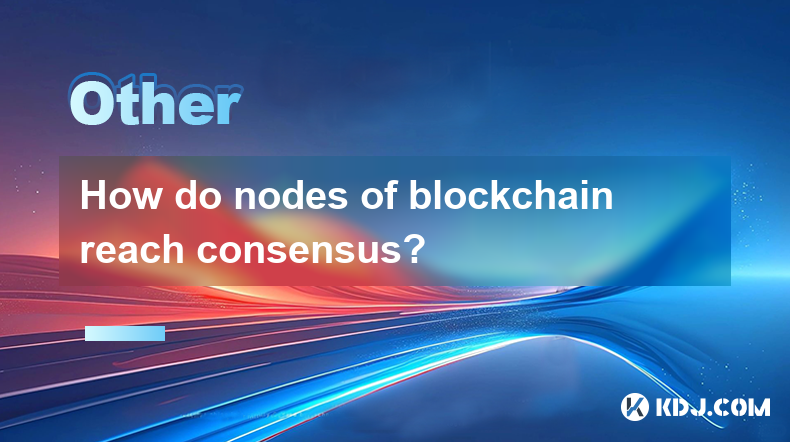
Understanding Blockchain Consensus Mechanisms
Blockchain technology relies on a distributed network of nodes to maintain a shared, immutable ledger. However, since these nodes are independent and potentially geographically dispersed, a mechanism is needed to ensure they all agree on the valid state of the blockchain. This is where consensus mechanisms come in. They are crucial for the security and integrity of the entire blockchain system. Without a robust consensus mechanism, the blockchain would be vulnerable to manipulation and attacks. Different blockchains employ various consensus mechanisms, each with its own strengths and weaknesses.
Proof-of-Work (PoW)
PoW is perhaps the most well-known consensus mechanism, famously used by Bitcoin. It involves nodes competing to solve complex cryptographic puzzles. The first node to solve the puzzle gets to add the next block of transactions to the blockchain and is rewarded with newly minted cryptocurrency. This process requires significant computational power, making it computationally expensive to attempt fraudulent transactions. The higher the computational power, the more secure the network becomes.
- Nodes receive pending transactions.
- Nodes compete to solve a cryptographic hash puzzle.
- The first node to solve the puzzle adds the block to the blockchain.
- Other nodes verify the block and add it to their copy of the blockchain.
This process ensures that only valid blocks are added to the blockchain, as altering a block would require immense computational resources and time to recalculate the hash. However, PoW's energy consumption is a significant drawback.
Proof-of-Stake (PoS)
PoS is an alternative consensus mechanism designed to address the energy consumption concerns of PoW. Instead of relying on computational power, PoS uses a node's stake in the cryptocurrency to determine its influence in the consensus process. Nodes with a larger stake have a higher probability of being selected to validate transactions and add blocks to the blockchain. This reduces the need for extensive computational power, making it more energy-efficient.
- Nodes stake their cryptocurrency.
- The blockchain randomly selects a validator based on stake size.
- The selected validator proposes and validates a new block.
- Other nodes verify the block.
PoS mechanisms vary; some use a random selection process, while others employ more complex algorithms to ensure fairness and security. The stake acts as a security deposit; validators who act maliciously risk losing their stake.
Delegated Proof-of-Stake (DPoS)
DPoS is a variation of PoS where token holders vote for delegates who will validate transactions and create blocks. This approach aims to improve efficiency and scalability by delegating the validation process to a smaller set of elected validators. Token holders can choose delegates they trust, ensuring a degree of accountability. However, it raises concerns about centralization, as the power to validate transactions is concentrated in the hands of a few delegates.
- Token holders vote for delegates.
- Selected delegates validate transactions and create blocks.
- Delegates are rewarded for their work.
- Token holders can switch their votes at any time.
This system is often faster than PoW and PoS, but the concentration of power could lead to vulnerabilities if a significant number of delegates collude.
Practical Byzantine Fault Tolerance (PBFT)
PBFT is a deterministic consensus algorithm designed for smaller, more tightly coupled networks. It's less scalable than PoW or PoS, but it offers very high fault tolerance. It can tolerate a certain percentage of faulty nodes without compromising the integrity of the system. PBFT is often used in permissioned blockchains, where the nodes are known and trusted entities.
- A node proposes a new block.
- Other nodes vote on the proposed block.
- If a supermajority of nodes agree, the block is added to the blockchain.
- If there's no consensus, the process is repeated.
The primary limitation of PBFT is its scalability; it struggles with large numbers of nodes.
Hybrid Consensus Mechanisms
Many modern blockchains employ hybrid consensus mechanisms that combine elements of different approaches. This allows them to leverage the strengths of various algorithms while mitigating their weaknesses. For example, a blockchain might use PoS for block creation and PBFT for finalizing the blocks, combining the efficiency of PoS with the high fault tolerance of PBFT. This approach offers a tailored solution depending on the specific needs of the blockchain.
Frequently Asked Questions
Q: What is the most energy-efficient consensus mechanism?
A: Proof-of-Stake (PoS) and its variations generally consume significantly less energy than Proof-of-Work (PoW).
Q: Which consensus mechanism is best for scalability?
A: There's no single "best" mechanism for scalability. DPoS can be more scalable than PoW or PoS in some cases, but it introduces centralization risks. Hybrid approaches often aim to balance scalability and security.
Q: How secure are these consensus mechanisms?
A: The security of each mechanism depends on its specific implementation and the network's size and participation. PoW is generally considered highly secure due to its computational requirements, while PoS relies on the economic incentives of staking.
Q: Can a blockchain be hacked if it uses a consensus mechanism?
A: While consensus mechanisms significantly enhance security, they are not foolproof. Exploits are possible, particularly if vulnerabilities exist in the implementation of the algorithm or if a significant portion of the network is compromised.
Q: What are the trade-offs between different consensus mechanisms?
A: The primary trade-offs involve security, scalability, energy consumption, and decentralization. PoW prioritizes security but consumes significant energy. PoS prioritizes energy efficiency but may be more vulnerable to attacks from large stakeholders. DPoS improves scalability but risks centralization. PBFT offers high fault tolerance but struggles with scalability. Hybrid approaches attempt to balance these trade-offs.
Disclaimer:info@kdj.com
The information provided is not trading advice. kdj.com does not assume any responsibility for any investments made based on the information provided in this article. Cryptocurrencies are highly volatile and it is highly recommended that you invest with caution after thorough research!
If you believe that the content used on this website infringes your copyright, please contact us immediately (info@kdj.com) and we will delete it promptly.
- South Korea Cracks the Whip on Unregistered Digital Asset Exchanges, Targeting Bans on KuCoin, BitMEX, and Others
- 2025-04-01 20:10:12
- Shytoshi Kusama's Cryptic New Location Hints at Big Changes Coming to the SHIB Ecosystem
- 2025-04-01 20:10:12
- The Best New Meme Coins to Join Now: BTFD Coin, Gigachad, and More
- 2025-04-01 20:05:12
- Russian Darknet Markets Dominate Bitcoin and TRON Drug Sales, TRM Labs Says
- 2025-04-01 20:05:12
- Bitcoin (BTC) Selling Pressure Has Dropped Sharply, Suggesting a Period of Consolidation
- 2025-04-01 20:00:12
- Strategy (MSTR) Acquires 22,048 Bitcoins (BTC) for $1.92 Billion at an Average Price of $86,969 per BTC
- 2025-04-01 20:00:12
Related knowledge
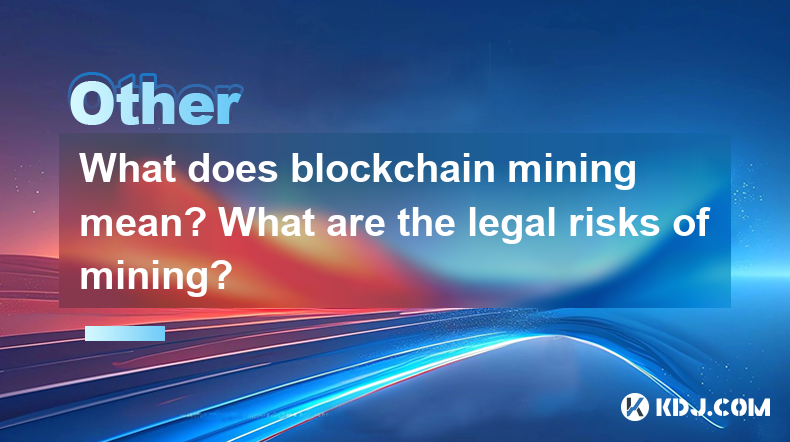
What does blockchain mining mean? What are the legal risks of mining?
Mar 31,2025 at 05:07pm
Blockchain mining is the process by which transactions are verified and added to the public ledger, known as the blockchain. Miners use powerful computers to solve complex mathematical problems, which, once solved, allow them to add a block of transactions to the blockchain. In return, miners are rewarded with cryptocurrency, typically Bitcoin. This pro...
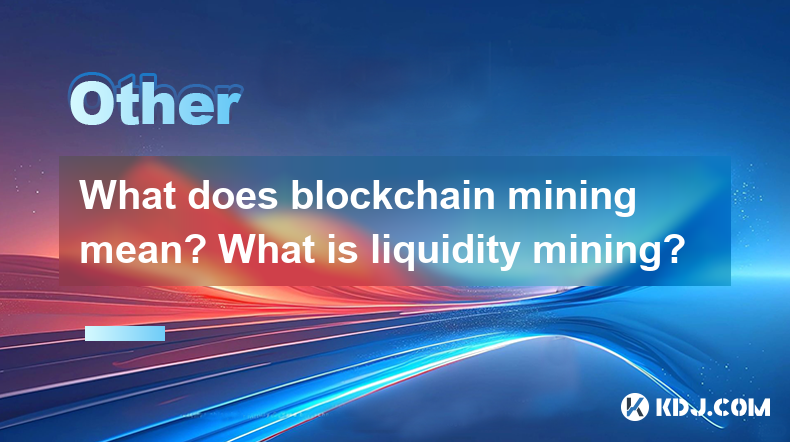
What does blockchain mining mean? What is liquidity mining?
Apr 01,2025 at 12:07am
What is Blockchain Mining?Blockchain mining is a critical process in the world of cryptocurrencies, particularly for networks like Bitcoin and Ethereum. It involves the use of computational power to solve complex mathematical problems, which in turn validates transactions and adds them to the blockchain. Miners are incentivized through rewards, typicall...
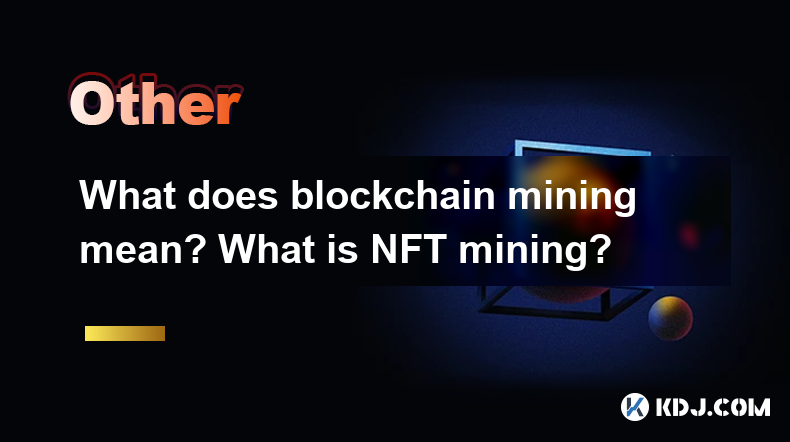
What does blockchain mining mean? What is NFT mining?
Mar 31,2025 at 04:07pm
Blockchain mining is a crucial process in the world of cryptocurrencies, particularly for networks like Bitcoin and Ethereum. It involves verifying transactions and adding them to the blockchain, a decentralized ledger. Miners use powerful computers to solve complex mathematical problems, which, when solved, allow them to add a block of transactions to ...

What does blockchain mining mean? What is the difference between cold wallets and hot wallets for mining?
Apr 01,2025 at 07:56am
Blockchain mining is a critical process in the world of cryptocurrencies. It involves verifying transactions and adding them to the blockchain, a decentralized ledger. Miners use powerful computers to solve complex mathematical problems, which, when solved, allow them to add a block of transactions to the blockchain. In return, miners are rewarded with ...
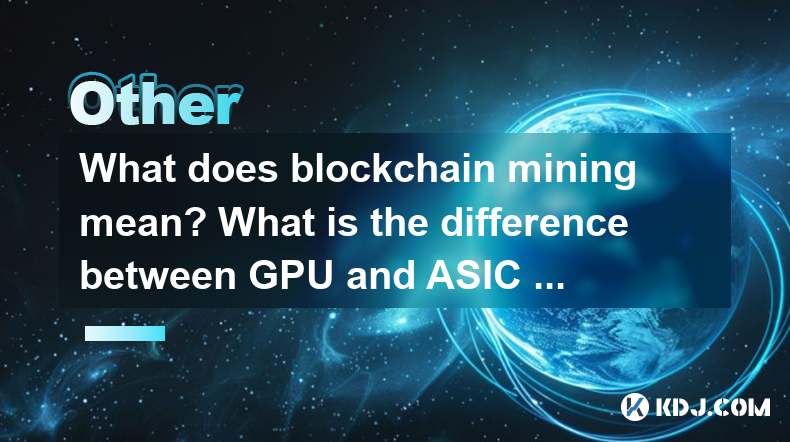
What does blockchain mining mean? What is the difference between GPU and ASIC mining?
Apr 01,2025 at 11:56am
Blockchain mining is a crucial process in the world of cryptocurrencies, particularly for networks like Bitcoin and Ethereum. At its core, mining involves solving complex mathematical problems to validate transactions and add them to the blockchain, a decentralized ledger. Miners compete to solve these problems, and the first to succeed is rewarded with...
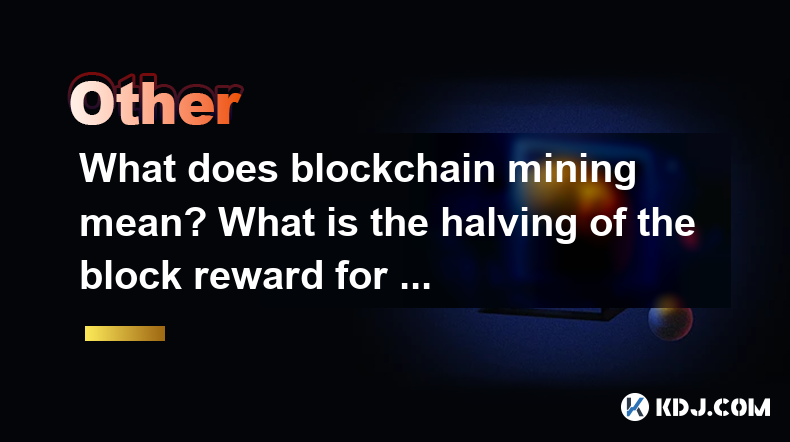
What does blockchain mining mean? What is the halving of the block reward for mining?
Mar 31,2025 at 03:43pm
Blockchain mining is a crucial process in the world of cryptocurrencies, particularly for networks like Bitcoin. It involves solving complex mathematical problems to validate transactions and add them to the blockchain, a public ledger of all cryptocurrency transactions. Miners use powerful computers to compete in solving these problems, and the first t...

What does blockchain mining mean? What are the legal risks of mining?
Mar 31,2025 at 05:07pm
Blockchain mining is the process by which transactions are verified and added to the public ledger, known as the blockchain. Miners use powerful computers to solve complex mathematical problems, which, once solved, allow them to add a block of transactions to the blockchain. In return, miners are rewarded with cryptocurrency, typically Bitcoin. This pro...

What does blockchain mining mean? What is liquidity mining?
Apr 01,2025 at 12:07am
What is Blockchain Mining?Blockchain mining is a critical process in the world of cryptocurrencies, particularly for networks like Bitcoin and Ethereum. It involves the use of computational power to solve complex mathematical problems, which in turn validates transactions and adds them to the blockchain. Miners are incentivized through rewards, typicall...

What does blockchain mining mean? What is NFT mining?
Mar 31,2025 at 04:07pm
Blockchain mining is a crucial process in the world of cryptocurrencies, particularly for networks like Bitcoin and Ethereum. It involves verifying transactions and adding them to the blockchain, a decentralized ledger. Miners use powerful computers to solve complex mathematical problems, which, when solved, allow them to add a block of transactions to ...

What does blockchain mining mean? What is the difference between cold wallets and hot wallets for mining?
Apr 01,2025 at 07:56am
Blockchain mining is a critical process in the world of cryptocurrencies. It involves verifying transactions and adding them to the blockchain, a decentralized ledger. Miners use powerful computers to solve complex mathematical problems, which, when solved, allow them to add a block of transactions to the blockchain. In return, miners are rewarded with ...

What does blockchain mining mean? What is the difference between GPU and ASIC mining?
Apr 01,2025 at 11:56am
Blockchain mining is a crucial process in the world of cryptocurrencies, particularly for networks like Bitcoin and Ethereum. At its core, mining involves solving complex mathematical problems to validate transactions and add them to the blockchain, a decentralized ledger. Miners compete to solve these problems, and the first to succeed is rewarded with...

What does blockchain mining mean? What is the halving of the block reward for mining?
Mar 31,2025 at 03:43pm
Blockchain mining is a crucial process in the world of cryptocurrencies, particularly for networks like Bitcoin. It involves solving complex mathematical problems to validate transactions and add them to the blockchain, a public ledger of all cryptocurrency transactions. Miners use powerful computers to compete in solving these problems, and the first t...
See all articles























































































